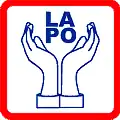Lift Above Poverty Organization
LAPO is a Nigerian organisation with a microfinance bank dedicated to self-employment through microfinance and an NGO, a non-governmental, non-profit community development organization focused on the empowerment of the poor and the vulnerable.[1]

LAPO focuses on assisting the poor, especially the women, in raising their socio-economic statuses. It not only acts as a microcredit institution, but also assists clients in overcoming problems beyond the lack of funds(Business capital), such as illiteracy and environmental degradation (which often aggravates poverty). Moreover, LAPO aims to enhance leadership skills, literacy status and political participation among poor women. It empowers women by providing opportunities for them to learn income generating skills such as sewing, food processing and soap making.
History
In 1987, the Lift Above Poverty Organization (LAPO) started as a non-profit entity at Ogwashi-Uku in present-day Delta State. The Institution was established as a Non-Governmental Organization (NGO) by Godwin Ehigiamusoe in response to the effects of the implementation of the Structural Adjustment Programme (SAP) in 1986. In 1991, the Ford Foundation gave a grant to LAPO. LAPO was formally incorporated as a non-profit, non-governmental organization with the Corporate Affairs Commission, a federal agency, in 1993. In 2004, LAPO scaled up as a sustainable and effective lending institution drawing inspiration from best practice model of Grameen and ASA methodology in Bangladesh.
In Nigeria, LAPO has partnered with the Grameen Bank. In 2010, LAPO transformed it's Microfinance activities into a regulated microfinance bank, LAPO Microfinance Bank limited, while the remaining activities continued under the LAPO NGO.
Financial services provided
LAPO provides poor Nigerians with the following financial services:[2]
Different types of loans
- Regular loan (RL), obtained by LAPO members through their groups as capital for entrepreneurship. Loan tenor is 32 weeks and equal amount of repayments with interest are paid weekly at group meetings.
- Festival Business Loan (FBL), which enables the clients to fund business activities during festive periods. The average loan size of FBL is US$200 and has benefited clients by ensuring them with high returns.
- Farming Loan, developed exclusively for food crop farmers, in which the disbursement and repayment schedules follow the pattern of activities in farming cycle.
- Credit-for-shares, allowing the poor to acquire and manage shares or stocks in profitable companies.
- Asset loans, which are designed for clients to invest in the acquisition of income generating assets such as commercial transportation and household appliances.
Savings programmes
There are also different types of savings programs for capital accumulation:
- Regular savings. Clients make mandatory weekly deposits into their savings accounts at group meetings which serve as funds for investment in capital accumulation. Withdrawal is only allowed at termination of relationship with LAPO.
- Voluntary savings, which are similarly introduced in order to aid clients with capital investment. Clients are motivated to set aside surplus funds, and so generate more funds by earning competitive interest rates on the balances.
Moreover, LAPO has set up a few subsidiaries to help tackle poverty in Nigeria. LAPO Agricultural and Rural Development Initiative (LARDI) was established to improve the lives of the rural poor in Nigeria. It helps to generate youth employment, to promote infrastructural development, to facilitate farmer’s access to capital and physical inputs such as credit, storing and processing facilities, to acquire information on relevant farming issues and to improve the farmers and rural households’ health.[3] Micro Investment Support Services (MISS) was set up to provide microcredit services to the poor Nigerian for income generating purposes.[4] Academy for Microfinance and Enterprise Development (AMED) was established to provide training and technical services to LAPO Group and other microfinance institutions.[5]
Positive impact
LAPO has helped many poor Nigerians to achieve their basic needs and a high percentage 66.7% of ex-clients indicated that the loan has helped them a lot.
Table 1: LAPO overall loan impact[6]
| Response | Frequency | Percentage | Cumulative percentage |
|---|---|---|---|
| Helped me a lot | 76 | 66.7 | 66.7 |
| Helped me a little | 35 | 30.7 | 97.4 |
| Didn't help me at all | 3 | 2.6 | 100.0 |
| Total | 114 | 100.0 |
Table 2: Effects of LAPO loan[7]
| Indicators | Frequency | Total surveyed | Percentage |
|---|---|---|---|
| More and better food | 48 | 132 | 36.4% |
| Improved housing | 42 | 132 | 31.8% |
| More informed | 22 | 132 | 16.7% |
| Education of children / self | 20 | 132 | 15.2% |
| Better family health | 16 | 132 | 12.1% |
| Joined social groups | 14 | 132 | 12.1% |
| Better / more clothing | 11 | 132 | 8.3% |
| Better / more furniture, utensils, and other home items | 5 | 132 | 3.8% |
| No help | 4 | 132 | 3.0% |
Negative aspects of LAPO
35.7% of ex-clients face difficulty in paying their loans, and many (usually second-loan clients) also find that the loan is too small.
Table 3: Loan Repayment Experience[8]
| Response | Frequency | Percentage | Cumulative percentage |
|---|---|---|---|
| Difficult to pay | 40 | 35.7 | 35.7 |
| Within my capacity to pay | 36 | 32.1 | 67.9 |
| Easy to pay | 36 | 32.1 | 100.0 |
| Total | 112 | 100.0 |
Table 4: Response to size of loan and number of loans provided[9]
From May 2010 Kiva Microfinance suspended fundraising for loans from LAPO and is refunding LAPO loans on the site that have yet to be fully funded.[10]
References
- http://www.lapo-ngo.org/
- http://www.lapo-nigeria.org/
- http://www.lapogroup.org/LARDI/
- http://www.lapogroup.org/MISS/
- http://www.lapogroup.org/LARDI/
- http://www2.ids.ac.uk/impact/publications/partner_publications/LAPO%20Client%20Exit%20Study%20Final%20Report.doc
- http://www2.ids.ac.uk/impact/publications/partner_publications/LAPO%20Client%20Exit%20Study%20Final%20Report.doc
- http://www2.ids.ac.uk/impact/publications/partner_publications/LAPO%20Client%20Exit%20Study%20Final%20Report.doc
- http://www2.ids.ac.uk/impact/publications/partner_publications/LAPO%20Client%20Exit%20Study%20Final%20Report.doc
- KIVA suspends LAPO May 6 2010